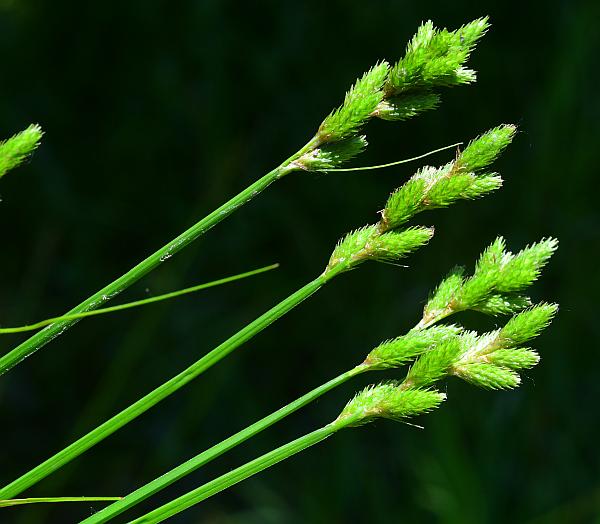Carex tribuloides Wahlenb.

Native
CC = 3
CW = -3
MOC = 89
© SRTurner
Carex tribuloides Wahlenb. | |
 |
Native CC = 3 CW = -3 MOC = 89 |
© SRTurner |
|
Family - Cyperaceae Habit - Monoecious sedge with short, inconspicuous rhizomes, forming tufts or clumps. Stems - Flowering stems 30-110 cm long, usually somewhat longer than the leaves. Vegetative stems abundant at flowering time, conspicuous and nearly as long as the flowering stems, the leaves well spaced along the apical half, occasionally becoming prostrate and rooting at the nodes. Leaves - Leaves with well-developed blades mostly 4-10 per flowering stem. Leaf blades 2-25 cm long, 3-7 mm wide, green to yellowish green. Leaf sheaths not extended past the insertion point of the leaf blade, the ventral side green nearly to the tip, the tip concave, the ligule longer than wide and U-shaped.
Inflorescences - Usually straight, the 4-15 spikes densely overlapping along the axis, the lowermost 1-3 spikes sometimes more loosely spaced. Spikes 6-16 mm long, 4-10 mm wide, the pistillate portion circular to ovate or obovate in outline, rounded at the tip, with numerous perigynia with appressed to ascending tips, at least the terminal spike narrowed to the short staminate portion, this often inconspicuous.
Perigynia - Scales 1.9-3.8 mm long, shorter and narrower than, but not hidden by the perigynia, narrowly ovate, mostly sharply pointed, white to pale brown, with a green midrib. Perigynia 2.8-5.5 mm long, 0.9-1.6 mm wide, 2.5-3.5 times as long as wide, flat or nearly so on both sides, the main body 1.5-3.0 times as long as wide, lanceolate to oblanceolate, widest near the middle, the distance from the tip of the fruit to the tip of the perigynium 0.8-2.2 mm, narrowly winged, the wing tapered abruptly from about the middle of the main body and usually ending above the base, tapered gradually to a beak with toothed or roughened margins, the wing ending more or less at the tip of the beak, the ventral and dorsal surfaces lacking papillae, finely 3-7-nerved on the ventral surface and finely 5-9-nerved on the dorsal surface, green to pale brown or brown. Fruits 1.2-1.6 mm long, 0.5-0.8 mm wide, narrowly oblong-ovate in outline, light brown.
Flowering - May - July. Habitat - Bottomland forests and prairies, swamps, streambanks, pond margins, seeps, fens, moist pastures, railroads, roadsides, moist disturbed areas. Origin - Native to the U.S. Lookalikes - C. molesta, C. normalis, and several others. Other info. - This sedge is relatively common across Missouri, and also ranges throughout the eastern half of the continental U.S. and Canada. It is a member of the notoriously difficult Ovales section, which contains numerous similar species. C. tribuloides is characterized by erect spikes containing tightly ascending and strongly flattened perigynia. The staminate region is located at the base of the terminal and some lateral spikes and is generally easily observed. The perigynia are broadly winged and translucent around the margins. The species grows in moist places, including disturbed sites. Photographs taken at Riverfront Park, Washington, Franklin County, MO, 6-4-2020, and along the Katy Trail near Dutzow, Warren County, MO, 6-6-2020 (SRTurner). |